Analyzing Human Resource Management Strategies: CERA Case Study Report
VerifiedAdded on 2020/04/01
|12
|3252
|150
Case Study
AI Summary
This assignment presents a case study analysis of CERA, a company facing challenges in human resource management. The report explores the importance of effective job design, examining various approaches including motivational, mechanistic, biological, and perpetual job design to enhance employee effectiveness and motivation. It critically analyzes recent literature on HRM, highlighting trends like globalization, workforce planning, and employee performance management. The study emphasizes the need for strategic approaches to overcome issues in workforce planning and the significance of drafting management in improving business services. Recommendations are provided to improve CERA's HRM practices, focusing on employee engagement, and strategic alignment to achieve organizational goals.
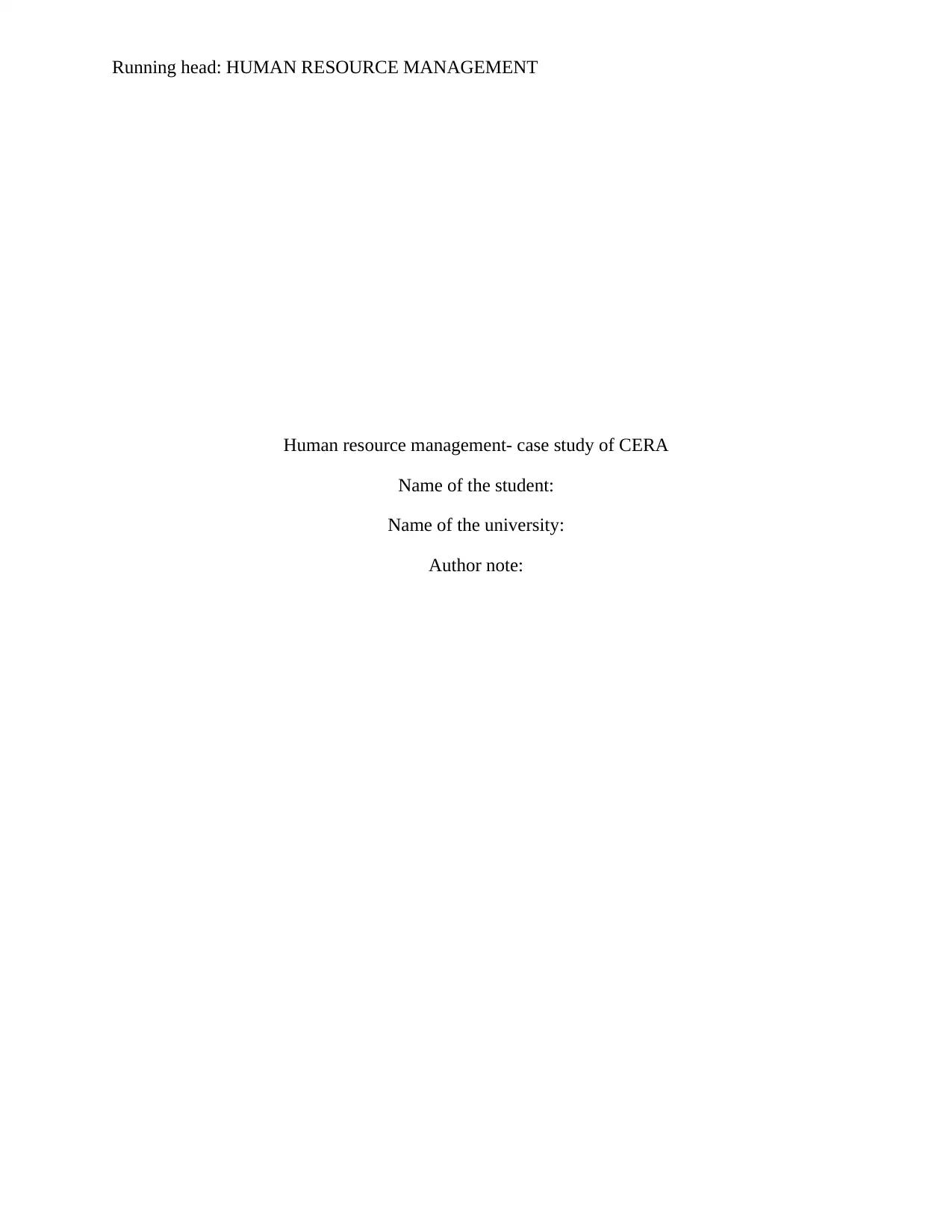
Running head: HUMAN RESOURCE MANAGEMENT
Human resource management- case study of CERA
Name of the student:
Name of the university:
Author note:
Human resource management- case study of CERA
Name of the student:
Name of the university:
Author note:
Paraphrase This Document
Need a fresh take? Get an instant paraphrase of this document with our AI Paraphraser
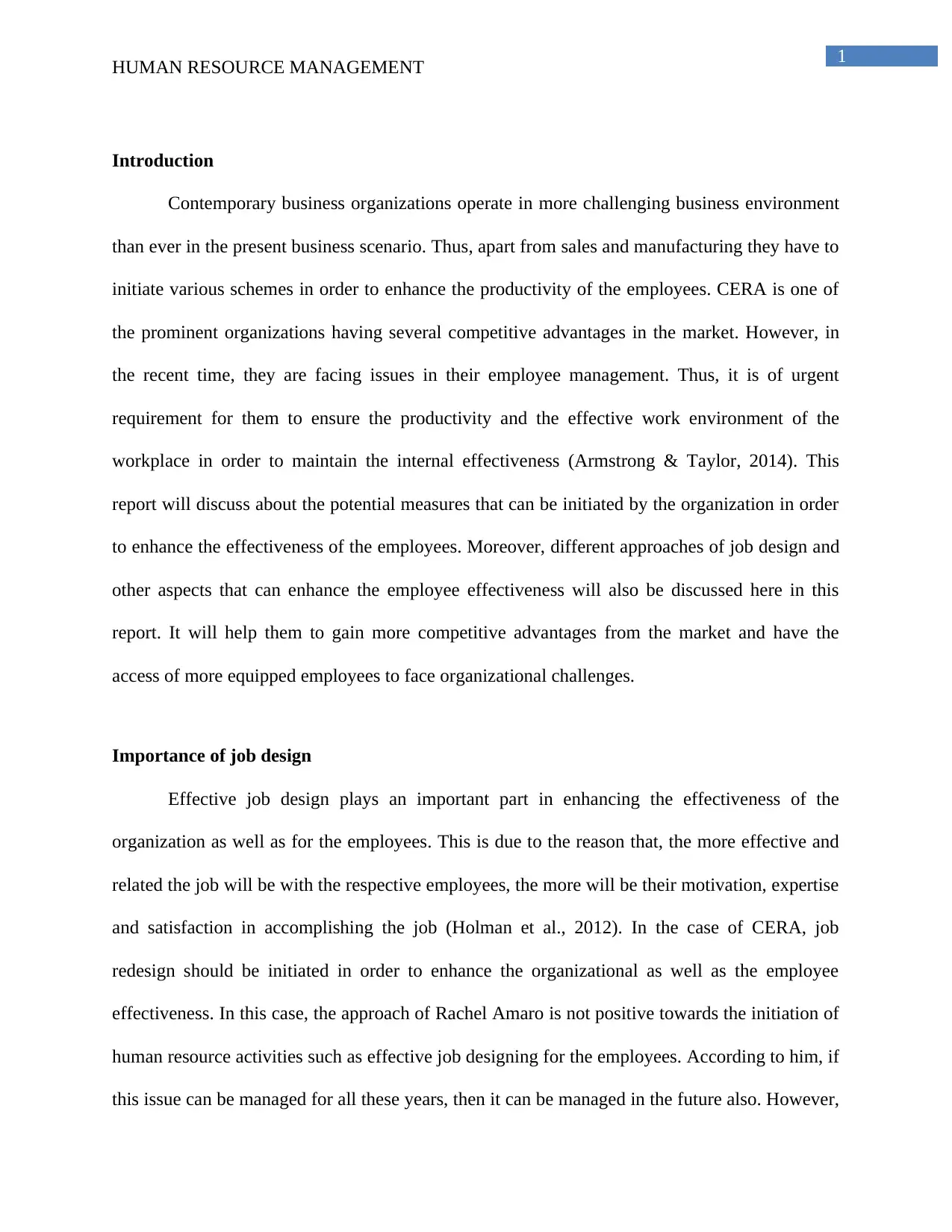
1
HUMAN RESOURCE MANAGEMENT
Introduction
Contemporary business organizations operate in more challenging business environment
than ever in the present business scenario. Thus, apart from sales and manufacturing they have to
initiate various schemes in order to enhance the productivity of the employees. CERA is one of
the prominent organizations having several competitive advantages in the market. However, in
the recent time, they are facing issues in their employee management. Thus, it is of urgent
requirement for them to ensure the productivity and the effective work environment of the
workplace in order to maintain the internal effectiveness (Armstrong & Taylor, 2014). This
report will discuss about the potential measures that can be initiated by the organization in order
to enhance the effectiveness of the employees. Moreover, different approaches of job design and
other aspects that can enhance the employee effectiveness will also be discussed here in this
report. It will help them to gain more competitive advantages from the market and have the
access of more equipped employees to face organizational challenges.
Importance of job design
Effective job design plays an important part in enhancing the effectiveness of the
organization as well as for the employees. This is due to the reason that, the more effective and
related the job will be with the respective employees, the more will be their motivation, expertise
and satisfaction in accomplishing the job (Holman et al., 2012). In the case of CERA, job
redesign should be initiated in order to enhance the organizational as well as the employee
effectiveness. In this case, the approach of Rachel Amaro is not positive towards the initiation of
human resource activities such as effective job designing for the employees. According to him, if
this issue can be managed for all these years, then it can be managed in the future also. However,
HUMAN RESOURCE MANAGEMENT
Introduction
Contemporary business organizations operate in more challenging business environment
than ever in the present business scenario. Thus, apart from sales and manufacturing they have to
initiate various schemes in order to enhance the productivity of the employees. CERA is one of
the prominent organizations having several competitive advantages in the market. However, in
the recent time, they are facing issues in their employee management. Thus, it is of urgent
requirement for them to ensure the productivity and the effective work environment of the
workplace in order to maintain the internal effectiveness (Armstrong & Taylor, 2014). This
report will discuss about the potential measures that can be initiated by the organization in order
to enhance the effectiveness of the employees. Moreover, different approaches of job design and
other aspects that can enhance the employee effectiveness will also be discussed here in this
report. It will help them to gain more competitive advantages from the market and have the
access of more equipped employees to face organizational challenges.
Importance of job design
Effective job design plays an important part in enhancing the effectiveness of the
organization as well as for the employees. This is due to the reason that, the more effective and
related the job will be with the respective employees, the more will be their motivation, expertise
and satisfaction in accomplishing the job (Holman et al., 2012). In the case of CERA, job
redesign should be initiated in order to enhance the organizational as well as the employee
effectiveness. In this case, the approach of Rachel Amaro is not positive towards the initiation of
human resource activities such as effective job designing for the employees. According to him, if
this issue can be managed for all these years, then it can be managed in the future also. However,
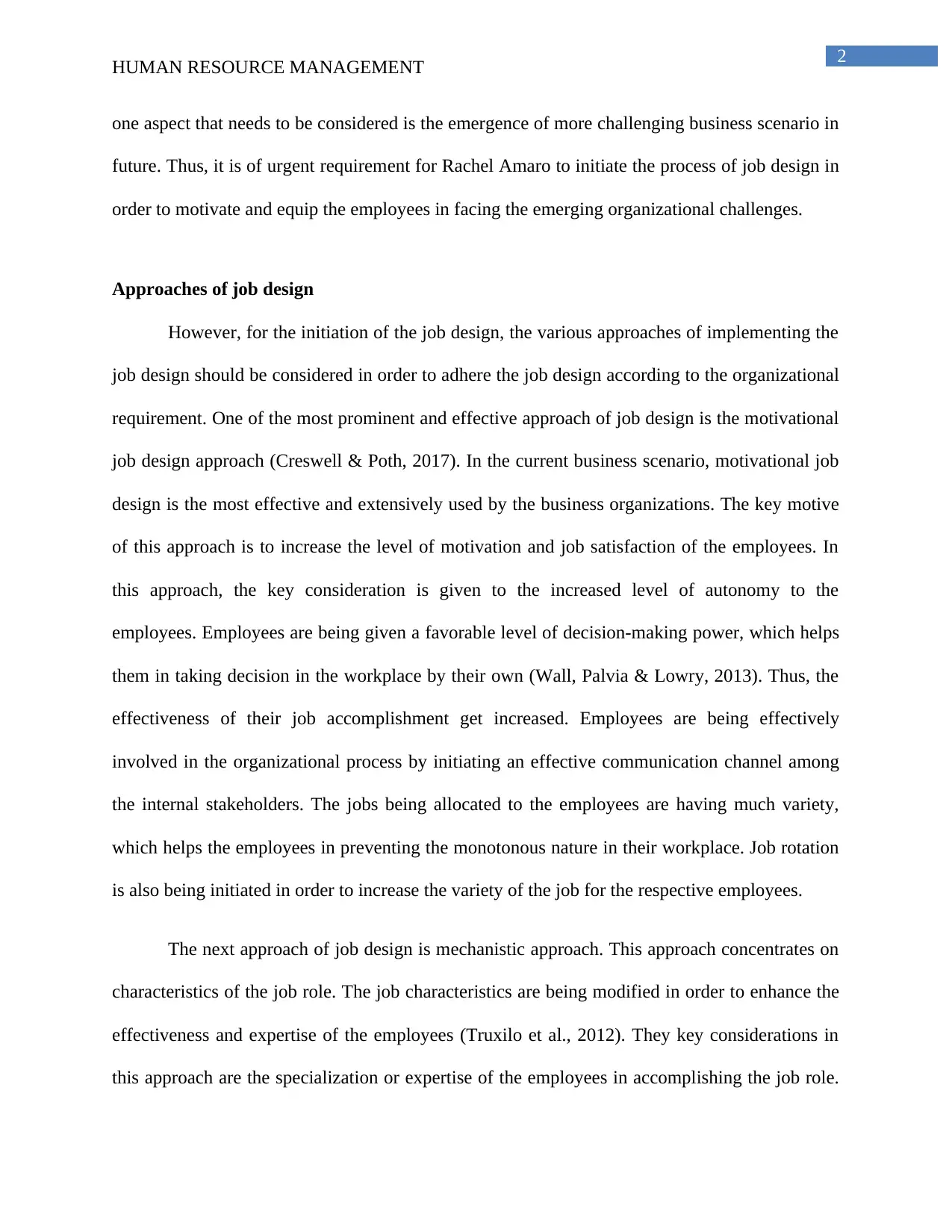
2
HUMAN RESOURCE MANAGEMENT
one aspect that needs to be considered is the emergence of more challenging business scenario in
future. Thus, it is of urgent requirement for Rachel Amaro to initiate the process of job design in
order to motivate and equip the employees in facing the emerging organizational challenges.
Approaches of job design
However, for the initiation of the job design, the various approaches of implementing the
job design should be considered in order to adhere the job design according to the organizational
requirement. One of the most prominent and effective approach of job design is the motivational
job design approach (Creswell & Poth, 2017). In the current business scenario, motivational job
design is the most effective and extensively used by the business organizations. The key motive
of this approach is to increase the level of motivation and job satisfaction of the employees. In
this approach, the key consideration is given to the increased level of autonomy to the
employees. Employees are being given a favorable level of decision-making power, which helps
them in taking decision in the workplace by their own (Wall, Palvia & Lowry, 2013). Thus, the
effectiveness of their job accomplishment get increased. Employees are being effectively
involved in the organizational process by initiating an effective communication channel among
the internal stakeholders. The jobs being allocated to the employees are having much variety,
which helps the employees in preventing the monotonous nature in their workplace. Job rotation
is also being initiated in order to increase the variety of the job for the respective employees.
The next approach of job design is mechanistic approach. This approach concentrates on
characteristics of the job role. The job characteristics are being modified in order to enhance the
effectiveness and expertise of the employees (Truxilo et al., 2012). They key considerations in
this approach are the specialization or expertise of the employees in accomplishing the job role.
HUMAN RESOURCE MANAGEMENT
one aspect that needs to be considered is the emergence of more challenging business scenario in
future. Thus, it is of urgent requirement for Rachel Amaro to initiate the process of job design in
order to motivate and equip the employees in facing the emerging organizational challenges.
Approaches of job design
However, for the initiation of the job design, the various approaches of implementing the
job design should be considered in order to adhere the job design according to the organizational
requirement. One of the most prominent and effective approach of job design is the motivational
job design approach (Creswell & Poth, 2017). In the current business scenario, motivational job
design is the most effective and extensively used by the business organizations. The key motive
of this approach is to increase the level of motivation and job satisfaction of the employees. In
this approach, the key consideration is given to the increased level of autonomy to the
employees. Employees are being given a favorable level of decision-making power, which helps
them in taking decision in the workplace by their own (Wall, Palvia & Lowry, 2013). Thus, the
effectiveness of their job accomplishment get increased. Employees are being effectively
involved in the organizational process by initiating an effective communication channel among
the internal stakeholders. The jobs being allocated to the employees are having much variety,
which helps the employees in preventing the monotonous nature in their workplace. Job rotation
is also being initiated in order to increase the variety of the job for the respective employees.
The next approach of job design is mechanistic approach. This approach concentrates on
characteristics of the job role. The job characteristics are being modified in order to enhance the
effectiveness and expertise of the employees (Truxilo et al., 2012). They key considerations in
this approach are the specialization or expertise of the employees in accomplishing the job role.
⊘ This is a preview!⊘
Do you want full access?
Subscribe today to unlock all pages.

Trusted by 1+ million students worldwide
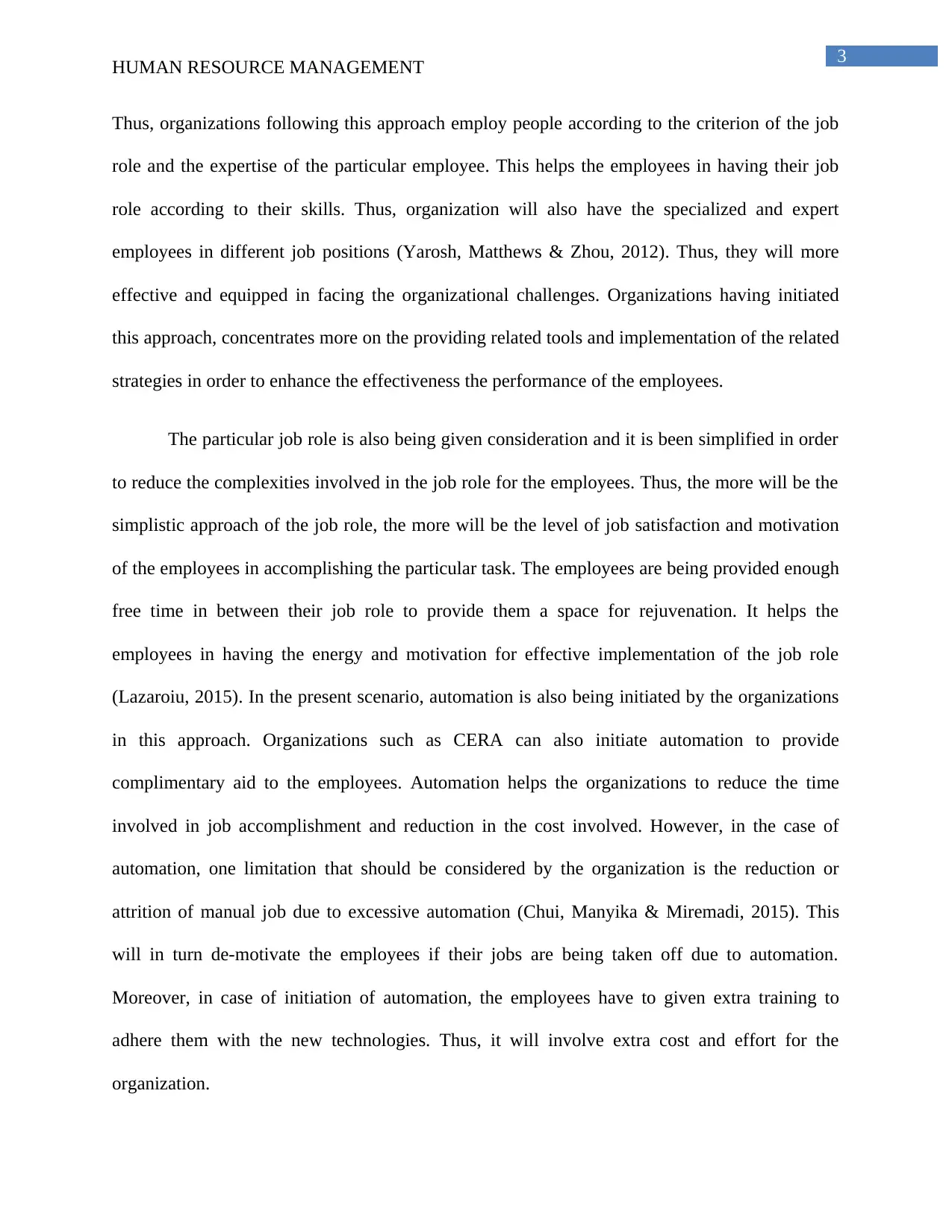
3
HUMAN RESOURCE MANAGEMENT
Thus, organizations following this approach employ people according to the criterion of the job
role and the expertise of the particular employee. This helps the employees in having their job
role according to their skills. Thus, organization will also have the specialized and expert
employees in different job positions (Yarosh, Matthews & Zhou, 2012). Thus, they will more
effective and equipped in facing the organizational challenges. Organizations having initiated
this approach, concentrates more on the providing related tools and implementation of the related
strategies in order to enhance the effectiveness the performance of the employees.
The particular job role is also being given consideration and it is been simplified in order
to reduce the complexities involved in the job role for the employees. Thus, the more will be the
simplistic approach of the job role, the more will be the level of job satisfaction and motivation
of the employees in accomplishing the particular task. The employees are being provided enough
free time in between their job role to provide them a space for rejuvenation. It helps the
employees in having the energy and motivation for effective implementation of the job role
(Lazaroiu, 2015). In the present scenario, automation is also being initiated by the organizations
in this approach. Organizations such as CERA can also initiate automation to provide
complimentary aid to the employees. Automation helps the organizations to reduce the time
involved in job accomplishment and reduction in the cost involved. However, in the case of
automation, one limitation that should be considered by the organization is the reduction or
attrition of manual job due to excessive automation (Chui, Manyika & Miremadi, 2015). This
will in turn de-motivate the employees if their jobs are being taken off due to automation.
Moreover, in case of initiation of automation, the employees have to given extra training to
adhere them with the new technologies. Thus, it will involve extra cost and effort for the
organization.
HUMAN RESOURCE MANAGEMENT
Thus, organizations following this approach employ people according to the criterion of the job
role and the expertise of the particular employee. This helps the employees in having their job
role according to their skills. Thus, organization will also have the specialized and expert
employees in different job positions (Yarosh, Matthews & Zhou, 2012). Thus, they will more
effective and equipped in facing the organizational challenges. Organizations having initiated
this approach, concentrates more on the providing related tools and implementation of the related
strategies in order to enhance the effectiveness the performance of the employees.
The particular job role is also being given consideration and it is been simplified in order
to reduce the complexities involved in the job role for the employees. Thus, the more will be the
simplistic approach of the job role, the more will be the level of job satisfaction and motivation
of the employees in accomplishing the particular task. The employees are being provided enough
free time in between their job role to provide them a space for rejuvenation. It helps the
employees in having the energy and motivation for effective implementation of the job role
(Lazaroiu, 2015). In the present scenario, automation is also being initiated by the organizations
in this approach. Organizations such as CERA can also initiate automation to provide
complimentary aid to the employees. Automation helps the organizations to reduce the time
involved in job accomplishment and reduction in the cost involved. However, in the case of
automation, one limitation that should be considered by the organization is the reduction or
attrition of manual job due to excessive automation (Chui, Manyika & Miremadi, 2015). This
will in turn de-motivate the employees if their jobs are being taken off due to automation.
Moreover, in case of initiation of automation, the employees have to given extra training to
adhere them with the new technologies. Thus, it will involve extra cost and effort for the
organization.
Paraphrase This Document
Need a fresh take? Get an instant paraphrase of this document with our AI Paraphraser
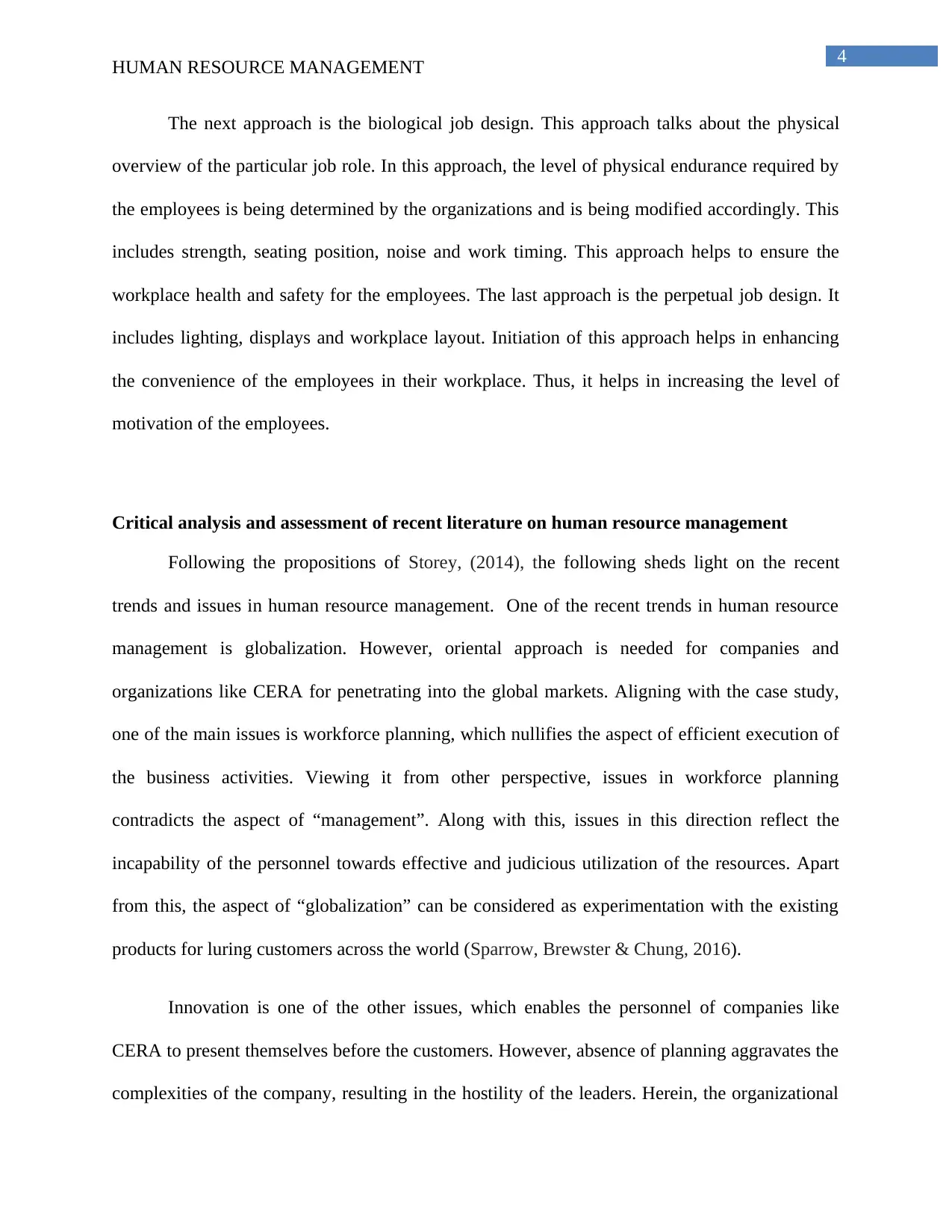
4
HUMAN RESOURCE MANAGEMENT
The next approach is the biological job design. This approach talks about the physical
overview of the particular job role. In this approach, the level of physical endurance required by
the employees is being determined by the organizations and is being modified accordingly. This
includes strength, seating position, noise and work timing. This approach helps to ensure the
workplace health and safety for the employees. The last approach is the perpetual job design. It
includes lighting, displays and workplace layout. Initiation of this approach helps in enhancing
the convenience of the employees in their workplace. Thus, it helps in increasing the level of
motivation of the employees.
Critical analysis and assessment of recent literature on human resource management
Following the propositions of Storey, (2014), the following sheds light on the recent
trends and issues in human resource management. One of the recent trends in human resource
management is globalization. However, oriental approach is needed for companies and
organizations like CERA for penetrating into the global markets. Aligning with the case study,
one of the main issues is workforce planning, which nullifies the aspect of efficient execution of
the business activities. Viewing it from other perspective, issues in workforce planning
contradicts the aspect of “management”. Along with this, issues in this direction reflect the
incapability of the personnel towards effective and judicious utilization of the resources. Apart
from this, the aspect of “globalization” can be considered as experimentation with the existing
products for luring customers across the world (Sparrow, Brewster & Chung, 2016).
Innovation is one of the other issues, which enables the personnel of companies like
CERA to present themselves before the customers. However, absence of planning aggravates the
complexities of the company, resulting in the hostility of the leaders. Herein, the organizational
HUMAN RESOURCE MANAGEMENT
The next approach is the biological job design. This approach talks about the physical
overview of the particular job role. In this approach, the level of physical endurance required by
the employees is being determined by the organizations and is being modified accordingly. This
includes strength, seating position, noise and work timing. This approach helps to ensure the
workplace health and safety for the employees. The last approach is the perpetual job design. It
includes lighting, displays and workplace layout. Initiation of this approach helps in enhancing
the convenience of the employees in their workplace. Thus, it helps in increasing the level of
motivation of the employees.
Critical analysis and assessment of recent literature on human resource management
Following the propositions of Storey, (2014), the following sheds light on the recent
trends and issues in human resource management. One of the recent trends in human resource
management is globalization. However, oriental approach is needed for companies and
organizations like CERA for penetrating into the global markets. Aligning with the case study,
one of the main issues is workforce planning, which nullifies the aspect of efficient execution of
the business activities. Viewing it from other perspective, issues in workforce planning
contradicts the aspect of “management”. Along with this, issues in this direction reflect the
incapability of the personnel towards effective and judicious utilization of the resources. Apart
from this, the aspect of “globalization” can be considered as experimentation with the existing
products for luring customers across the world (Sparrow, Brewster & Chung, 2016).
Innovation is one of the other issues, which enables the personnel of companies like
CERA to present themselves before the customers. However, absence of planning aggravates the
complexities of the company, resulting in the hostility of the leaders. Herein, the organizational
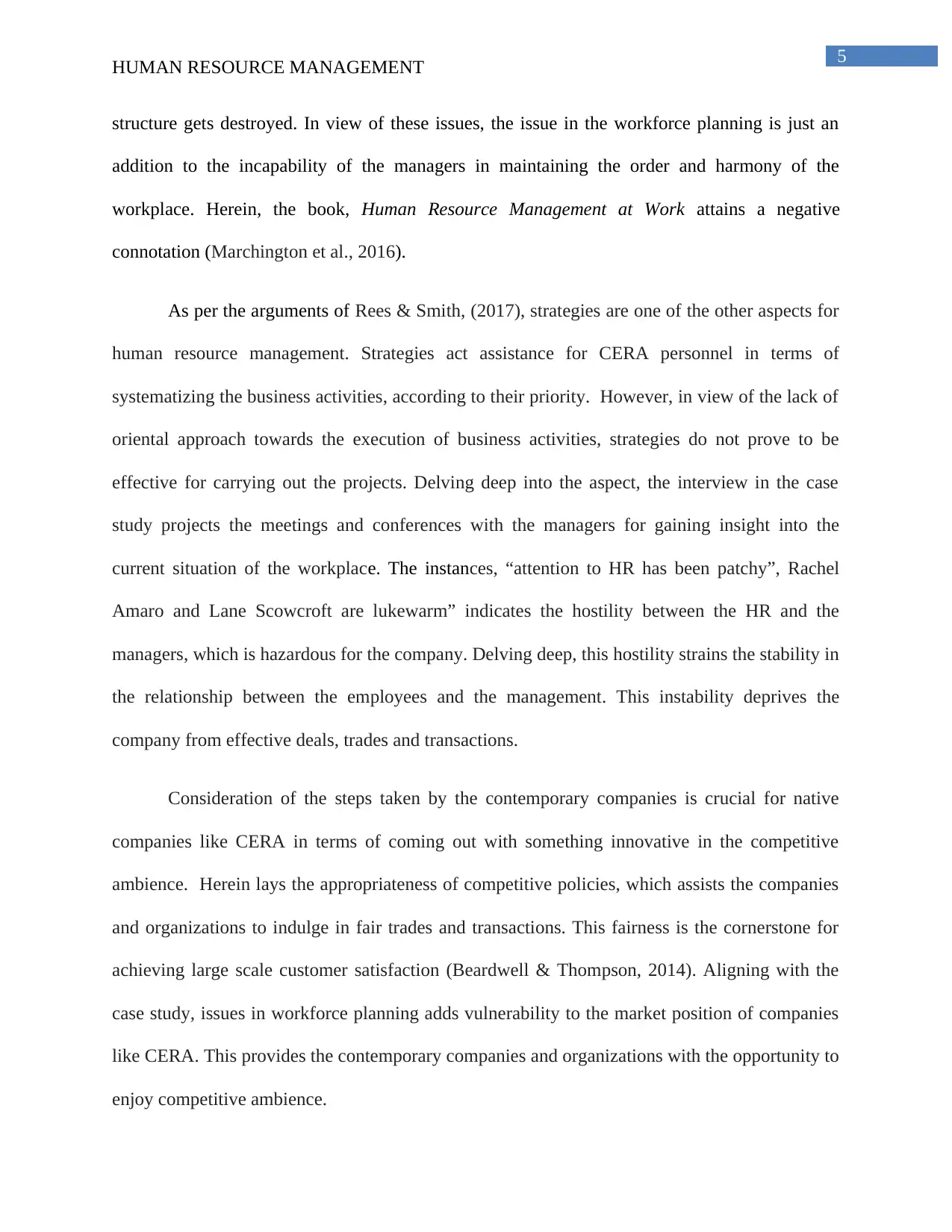
5
HUMAN RESOURCE MANAGEMENT
structure gets destroyed. In view of these issues, the issue in the workforce planning is just an
addition to the incapability of the managers in maintaining the order and harmony of the
workplace. Herein, the book, Human Resource Management at Work attains a negative
connotation (Marchington et al., 2016).
As per the arguments of Rees & Smith, (2017), strategies are one of the other aspects for
human resource management. Strategies act assistance for CERA personnel in terms of
systematizing the business activities, according to their priority. However, in view of the lack of
oriental approach towards the execution of business activities, strategies do not prove to be
effective for carrying out the projects. Delving deep into the aspect, the interview in the case
study projects the meetings and conferences with the managers for gaining insight into the
current situation of the workplace. The instances, “attention to HR has been patchy”, Rachel
Amaro and Lane Scowcroft are lukewarm” indicates the hostility between the HR and the
managers, which is hazardous for the company. Delving deep, this hostility strains the stability in
the relationship between the employees and the management. This instability deprives the
company from effective deals, trades and transactions.
Consideration of the steps taken by the contemporary companies is crucial for native
companies like CERA in terms of coming out with something innovative in the competitive
ambience. Herein lays the appropriateness of competitive policies, which assists the companies
and organizations to indulge in fair trades and transactions. This fairness is the cornerstone for
achieving large scale customer satisfaction (Beardwell & Thompson, 2014). Aligning with the
case study, issues in workforce planning adds vulnerability to the market position of companies
like CERA. This provides the contemporary companies and organizations with the opportunity to
enjoy competitive ambience.
HUMAN RESOURCE MANAGEMENT
structure gets destroyed. In view of these issues, the issue in the workforce planning is just an
addition to the incapability of the managers in maintaining the order and harmony of the
workplace. Herein, the book, Human Resource Management at Work attains a negative
connotation (Marchington et al., 2016).
As per the arguments of Rees & Smith, (2017), strategies are one of the other aspects for
human resource management. Strategies act assistance for CERA personnel in terms of
systematizing the business activities, according to their priority. However, in view of the lack of
oriental approach towards the execution of business activities, strategies do not prove to be
effective for carrying out the projects. Delving deep into the aspect, the interview in the case
study projects the meetings and conferences with the managers for gaining insight into the
current situation of the workplace. The instances, “attention to HR has been patchy”, Rachel
Amaro and Lane Scowcroft are lukewarm” indicates the hostility between the HR and the
managers, which is hazardous for the company. Delving deep, this hostility strains the stability in
the relationship between the employees and the management. This instability deprives the
company from effective deals, trades and transactions.
Consideration of the steps taken by the contemporary companies is crucial for native
companies like CERA in terms of coming out with something innovative in the competitive
ambience. Herein lays the appropriateness of competitive policies, which assists the companies
and organizations to indulge in fair trades and transactions. This fairness is the cornerstone for
achieving large scale customer satisfaction (Beardwell & Thompson, 2014). Aligning with the
case study, issues in workforce planning adds vulnerability to the market position of companies
like CERA. This provides the contemporary companies and organizations with the opportunity to
enjoy competitive ambience.
⊘ This is a preview!⊘
Do you want full access?
Subscribe today to unlock all pages.

Trusted by 1+ million students worldwide
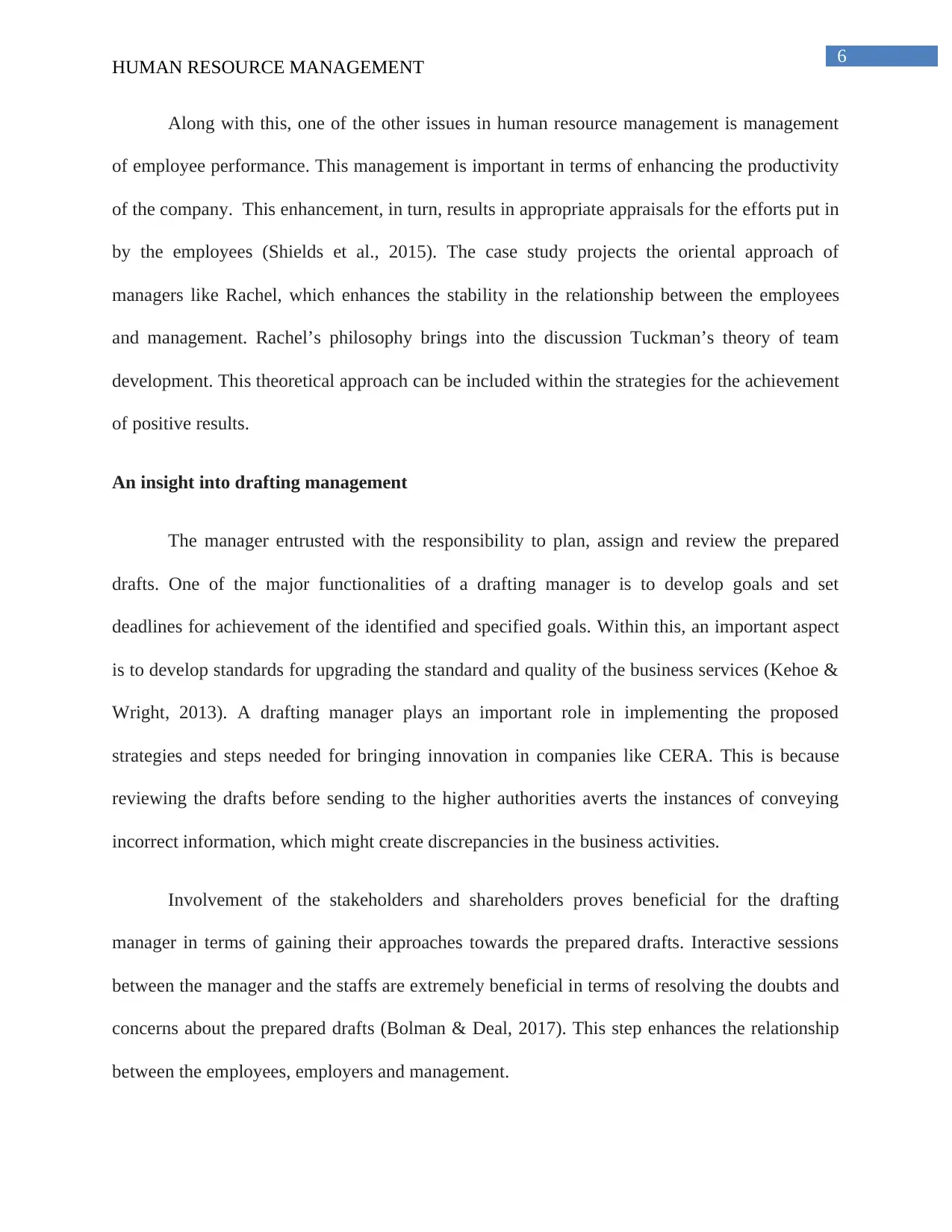
6
HUMAN RESOURCE MANAGEMENT
Along with this, one of the other issues in human resource management is management
of employee performance. This management is important in terms of enhancing the productivity
of the company. This enhancement, in turn, results in appropriate appraisals for the efforts put in
by the employees (Shields et al., 2015). The case study projects the oriental approach of
managers like Rachel, which enhances the stability in the relationship between the employees
and management. Rachel’s philosophy brings into the discussion Tuckman’s theory of team
development. This theoretical approach can be included within the strategies for the achievement
of positive results.
An insight into drafting management
The manager entrusted with the responsibility to plan, assign and review the prepared
drafts. One of the major functionalities of a drafting manager is to develop goals and set
deadlines for achievement of the identified and specified goals. Within this, an important aspect
is to develop standards for upgrading the standard and quality of the business services (Kehoe &
Wright, 2013). A drafting manager plays an important role in implementing the proposed
strategies and steps needed for bringing innovation in companies like CERA. This is because
reviewing the drafts before sending to the higher authorities averts the instances of conveying
incorrect information, which might create discrepancies in the business activities.
Involvement of the stakeholders and shareholders proves beneficial for the drafting
manager in terms of gaining their approaches towards the prepared drafts. Interactive sessions
between the manager and the staffs are extremely beneficial in terms of resolving the doubts and
concerns about the prepared drafts (Bolman & Deal, 2017). This step enhances the relationship
between the employees, employers and management.
HUMAN RESOURCE MANAGEMENT
Along with this, one of the other issues in human resource management is management
of employee performance. This management is important in terms of enhancing the productivity
of the company. This enhancement, in turn, results in appropriate appraisals for the efforts put in
by the employees (Shields et al., 2015). The case study projects the oriental approach of
managers like Rachel, which enhances the stability in the relationship between the employees
and management. Rachel’s philosophy brings into the discussion Tuckman’s theory of team
development. This theoretical approach can be included within the strategies for the achievement
of positive results.
An insight into drafting management
The manager entrusted with the responsibility to plan, assign and review the prepared
drafts. One of the major functionalities of a drafting manager is to develop goals and set
deadlines for achievement of the identified and specified goals. Within this, an important aspect
is to develop standards for upgrading the standard and quality of the business services (Kehoe &
Wright, 2013). A drafting manager plays an important role in implementing the proposed
strategies and steps needed for bringing innovation in companies like CERA. This is because
reviewing the drafts before sending to the higher authorities averts the instances of conveying
incorrect information, which might create discrepancies in the business activities.
Involvement of the stakeholders and shareholders proves beneficial for the drafting
manager in terms of gaining their approaches towards the prepared drafts. Interactive sessions
between the manager and the staffs are extremely beneficial in terms of resolving the doubts and
concerns about the prepared drafts (Bolman & Deal, 2017). This step enhances the relationship
between the employees, employers and management.
Paraphrase This Document
Need a fresh take? Get an instant paraphrase of this document with our AI Paraphraser
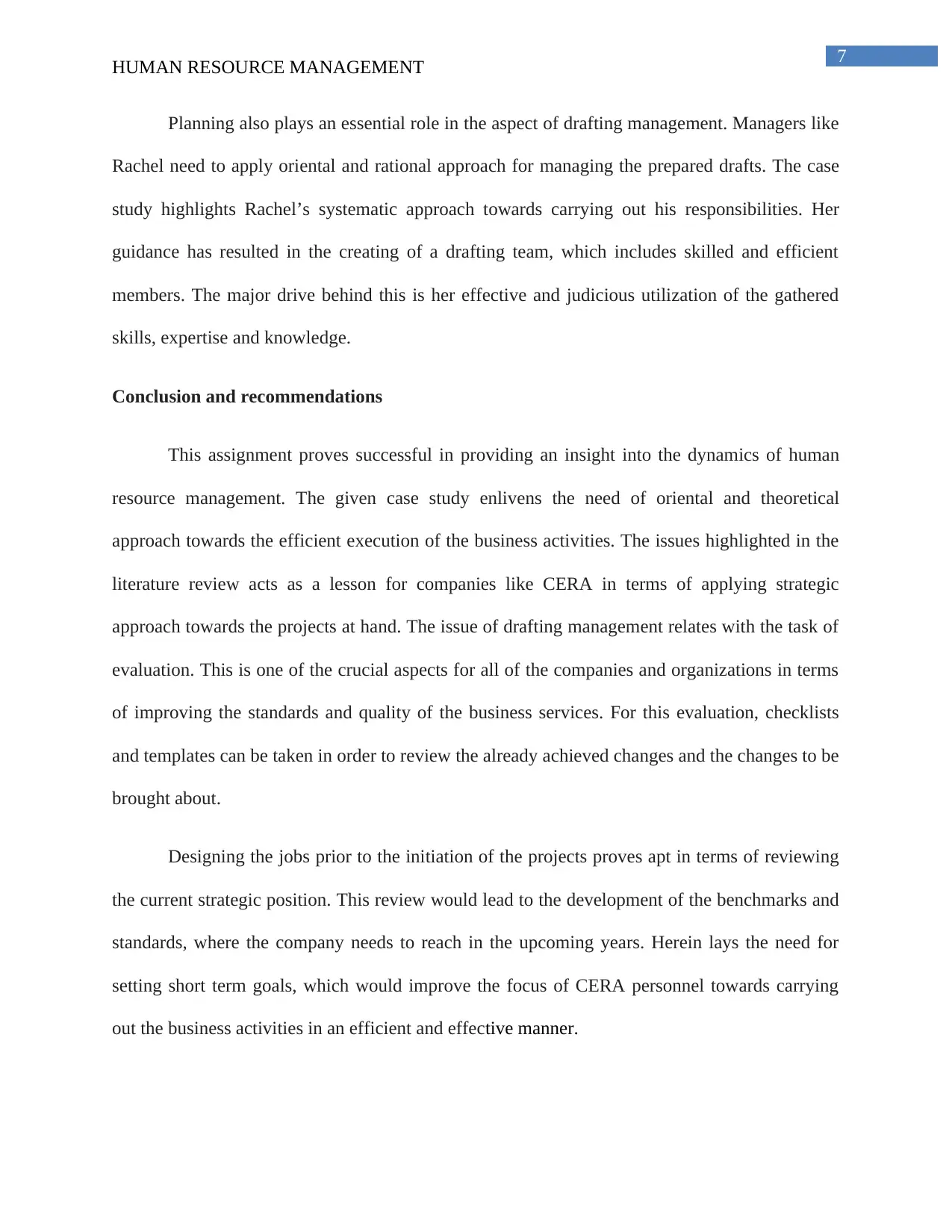
7
HUMAN RESOURCE MANAGEMENT
Planning also plays an essential role in the aspect of drafting management. Managers like
Rachel need to apply oriental and rational approach for managing the prepared drafts. The case
study highlights Rachel’s systematic approach towards carrying out his responsibilities. Her
guidance has resulted in the creating of a drafting team, which includes skilled and efficient
members. The major drive behind this is her effective and judicious utilization of the gathered
skills, expertise and knowledge.
Conclusion and recommendations
This assignment proves successful in providing an insight into the dynamics of human
resource management. The given case study enlivens the need of oriental and theoretical
approach towards the efficient execution of the business activities. The issues highlighted in the
literature review acts as a lesson for companies like CERA in terms of applying strategic
approach towards the projects at hand. The issue of drafting management relates with the task of
evaluation. This is one of the crucial aspects for all of the companies and organizations in terms
of improving the standards and quality of the business services. For this evaluation, checklists
and templates can be taken in order to review the already achieved changes and the changes to be
brought about.
Designing the jobs prior to the initiation of the projects proves apt in terms of reviewing
the current strategic position. This review would lead to the development of the benchmarks and
standards, where the company needs to reach in the upcoming years. Herein lays the need for
setting short term goals, which would improve the focus of CERA personnel towards carrying
out the business activities in an efficient and effective manner.
HUMAN RESOURCE MANAGEMENT
Planning also plays an essential role in the aspect of drafting management. Managers like
Rachel need to apply oriental and rational approach for managing the prepared drafts. The case
study highlights Rachel’s systematic approach towards carrying out his responsibilities. Her
guidance has resulted in the creating of a drafting team, which includes skilled and efficient
members. The major drive behind this is her effective and judicious utilization of the gathered
skills, expertise and knowledge.
Conclusion and recommendations
This assignment proves successful in providing an insight into the dynamics of human
resource management. The given case study enlivens the need of oriental and theoretical
approach towards the efficient execution of the business activities. The issues highlighted in the
literature review acts as a lesson for companies like CERA in terms of applying strategic
approach towards the projects at hand. The issue of drafting management relates with the task of
evaluation. This is one of the crucial aspects for all of the companies and organizations in terms
of improving the standards and quality of the business services. For this evaluation, checklists
and templates can be taken in order to review the already achieved changes and the changes to be
brought about.
Designing the jobs prior to the initiation of the projects proves apt in terms of reviewing
the current strategic position. This review would lead to the development of the benchmarks and
standards, where the company needs to reach in the upcoming years. Herein lays the need for
setting short term goals, which would improve the focus of CERA personnel towards carrying
out the business activities in an efficient and effective manner.
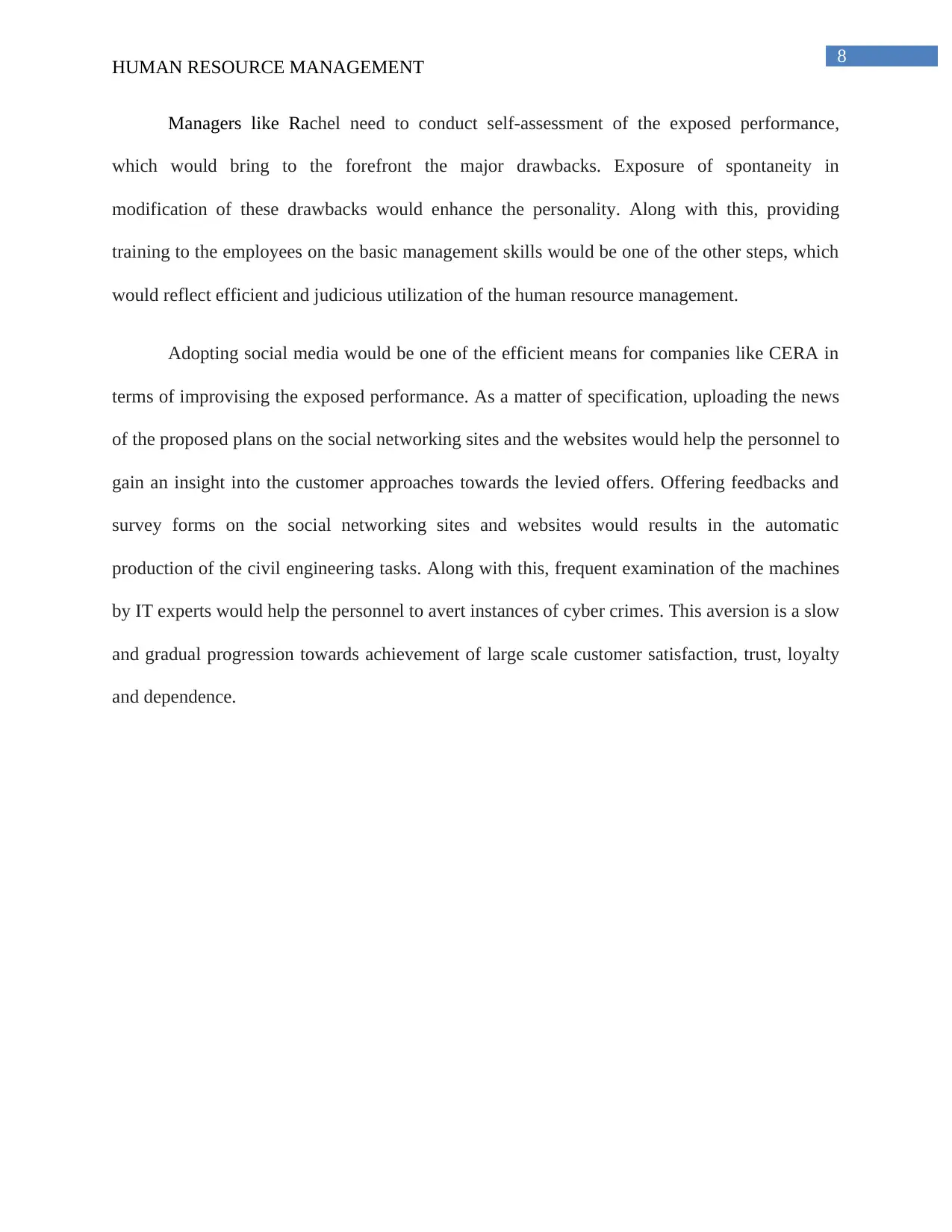
8
HUMAN RESOURCE MANAGEMENT
Managers like Rachel need to conduct self-assessment of the exposed performance,
which would bring to the forefront the major drawbacks. Exposure of spontaneity in
modification of these drawbacks would enhance the personality. Along with this, providing
training to the employees on the basic management skills would be one of the other steps, which
would reflect efficient and judicious utilization of the human resource management.
Adopting social media would be one of the efficient means for companies like CERA in
terms of improvising the exposed performance. As a matter of specification, uploading the news
of the proposed plans on the social networking sites and the websites would help the personnel to
gain an insight into the customer approaches towards the levied offers. Offering feedbacks and
survey forms on the social networking sites and websites would results in the automatic
production of the civil engineering tasks. Along with this, frequent examination of the machines
by IT experts would help the personnel to avert instances of cyber crimes. This aversion is a slow
and gradual progression towards achievement of large scale customer satisfaction, trust, loyalty
and dependence.
HUMAN RESOURCE MANAGEMENT
Managers like Rachel need to conduct self-assessment of the exposed performance,
which would bring to the forefront the major drawbacks. Exposure of spontaneity in
modification of these drawbacks would enhance the personality. Along with this, providing
training to the employees on the basic management skills would be one of the other steps, which
would reflect efficient and judicious utilization of the human resource management.
Adopting social media would be one of the efficient means for companies like CERA in
terms of improvising the exposed performance. As a matter of specification, uploading the news
of the proposed plans on the social networking sites and the websites would help the personnel to
gain an insight into the customer approaches towards the levied offers. Offering feedbacks and
survey forms on the social networking sites and websites would results in the automatic
production of the civil engineering tasks. Along with this, frequent examination of the machines
by IT experts would help the personnel to avert instances of cyber crimes. This aversion is a slow
and gradual progression towards achievement of large scale customer satisfaction, trust, loyalty
and dependence.
⊘ This is a preview!⊘
Do you want full access?
Subscribe today to unlock all pages.

Trusted by 1+ million students worldwide
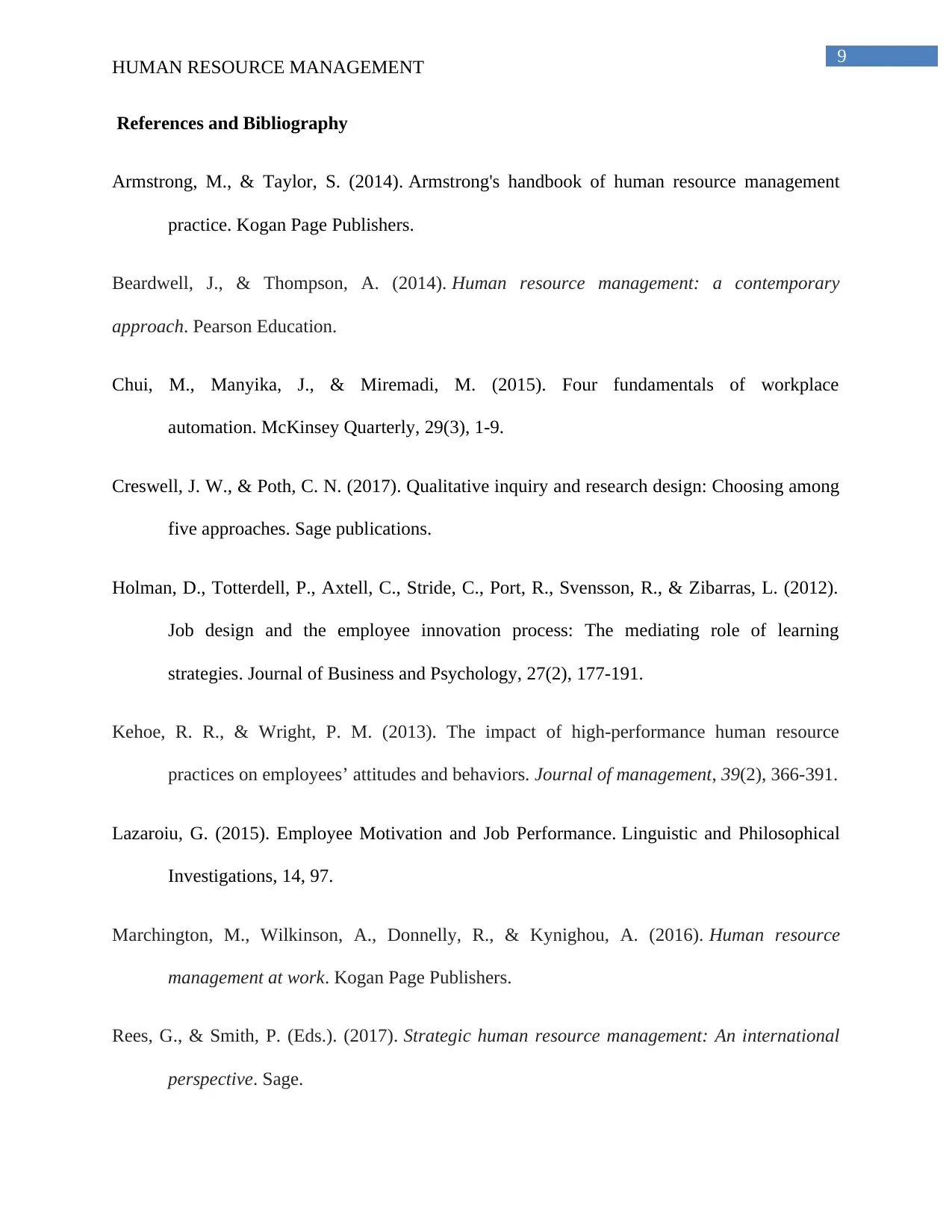
9
HUMAN RESOURCE MANAGEMENT
References and Bibliography
Armstrong, M., & Taylor, S. (2014). Armstrong's handbook of human resource management
practice. Kogan Page Publishers.
Beardwell, J., & Thompson, A. (2014). Human resource management: a contemporary
approach. Pearson Education.
Chui, M., Manyika, J., & Miremadi, M. (2015). Four fundamentals of workplace
automation. McKinsey Quarterly, 29(3), 1-9.
Creswell, J. W., & Poth, C. N. (2017). Qualitative inquiry and research design: Choosing among
five approaches. Sage publications.
Holman, D., Totterdell, P., Axtell, C., Stride, C., Port, R., Svensson, R., & Zibarras, L. (2012).
Job design and the employee innovation process: The mediating role of learning
strategies. Journal of Business and Psychology, 27(2), 177-191.
Kehoe, R. R., & Wright, P. M. (2013). The impact of high-performance human resource
practices on employees’ attitudes and behaviors. Journal of management, 39(2), 366-391.
Lazaroiu, G. (2015). Employee Motivation and Job Performance. Linguistic and Philosophical
Investigations, 14, 97.
Marchington, M., Wilkinson, A., Donnelly, R., & Kynighou, A. (2016). Human resource
management at work. Kogan Page Publishers.
Rees, G., & Smith, P. (Eds.). (2017). Strategic human resource management: An international
perspective. Sage.
HUMAN RESOURCE MANAGEMENT
References and Bibliography
Armstrong, M., & Taylor, S. (2014). Armstrong's handbook of human resource management
practice. Kogan Page Publishers.
Beardwell, J., & Thompson, A. (2014). Human resource management: a contemporary
approach. Pearson Education.
Chui, M., Manyika, J., & Miremadi, M. (2015). Four fundamentals of workplace
automation. McKinsey Quarterly, 29(3), 1-9.
Creswell, J. W., & Poth, C. N. (2017). Qualitative inquiry and research design: Choosing among
five approaches. Sage publications.
Holman, D., Totterdell, P., Axtell, C., Stride, C., Port, R., Svensson, R., & Zibarras, L. (2012).
Job design and the employee innovation process: The mediating role of learning
strategies. Journal of Business and Psychology, 27(2), 177-191.
Kehoe, R. R., & Wright, P. M. (2013). The impact of high-performance human resource
practices on employees’ attitudes and behaviors. Journal of management, 39(2), 366-391.
Lazaroiu, G. (2015). Employee Motivation and Job Performance. Linguistic and Philosophical
Investigations, 14, 97.
Marchington, M., Wilkinson, A., Donnelly, R., & Kynighou, A. (2016). Human resource
management at work. Kogan Page Publishers.
Rees, G., & Smith, P. (Eds.). (2017). Strategic human resource management: An international
perspective. Sage.
Paraphrase This Document
Need a fresh take? Get an instant paraphrase of this document with our AI Paraphraser
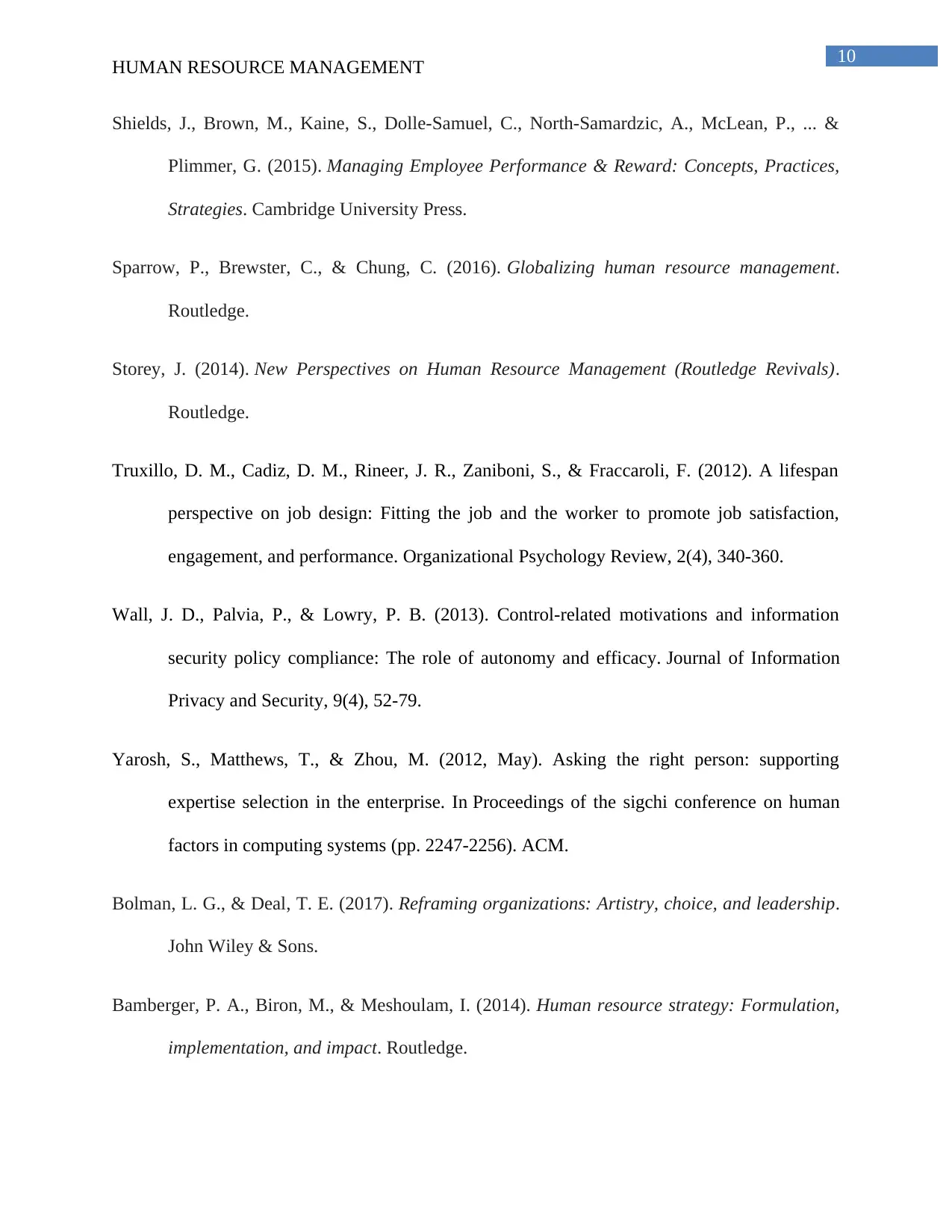
10
HUMAN RESOURCE MANAGEMENT
Shields, J., Brown, M., Kaine, S., Dolle-Samuel, C., North-Samardzic, A., McLean, P., ... &
Plimmer, G. (2015). Managing Employee Performance & Reward: Concepts, Practices,
Strategies. Cambridge University Press.
Sparrow, P., Brewster, C., & Chung, C. (2016). Globalizing human resource management.
Routledge.
Storey, J. (2014). New Perspectives on Human Resource Management (Routledge Revivals).
Routledge.
Truxillo, D. M., Cadiz, D. M., Rineer, J. R., Zaniboni, S., & Fraccaroli, F. (2012). A lifespan
perspective on job design: Fitting the job and the worker to promote job satisfaction,
engagement, and performance. Organizational Psychology Review, 2(4), 340-360.
Wall, J. D., Palvia, P., & Lowry, P. B. (2013). Control-related motivations and information
security policy compliance: The role of autonomy and efficacy. Journal of Information
Privacy and Security, 9(4), 52-79.
Yarosh, S., Matthews, T., & Zhou, M. (2012, May). Asking the right person: supporting
expertise selection in the enterprise. In Proceedings of the sigchi conference on human
factors in computing systems (pp. 2247-2256). ACM.
Bolman, L. G., & Deal, T. E. (2017). Reframing organizations: Artistry, choice, and leadership.
John Wiley & Sons.
Bamberger, P. A., Biron, M., & Meshoulam, I. (2014). Human resource strategy: Formulation,
implementation, and impact. Routledge.
HUMAN RESOURCE MANAGEMENT
Shields, J., Brown, M., Kaine, S., Dolle-Samuel, C., North-Samardzic, A., McLean, P., ... &
Plimmer, G. (2015). Managing Employee Performance & Reward: Concepts, Practices,
Strategies. Cambridge University Press.
Sparrow, P., Brewster, C., & Chung, C. (2016). Globalizing human resource management.
Routledge.
Storey, J. (2014). New Perspectives on Human Resource Management (Routledge Revivals).
Routledge.
Truxillo, D. M., Cadiz, D. M., Rineer, J. R., Zaniboni, S., & Fraccaroli, F. (2012). A lifespan
perspective on job design: Fitting the job and the worker to promote job satisfaction,
engagement, and performance. Organizational Psychology Review, 2(4), 340-360.
Wall, J. D., Palvia, P., & Lowry, P. B. (2013). Control-related motivations and information
security policy compliance: The role of autonomy and efficacy. Journal of Information
Privacy and Security, 9(4), 52-79.
Yarosh, S., Matthews, T., & Zhou, M. (2012, May). Asking the right person: supporting
expertise selection in the enterprise. In Proceedings of the sigchi conference on human
factors in computing systems (pp. 2247-2256). ACM.
Bolman, L. G., & Deal, T. E. (2017). Reframing organizations: Artistry, choice, and leadership.
John Wiley & Sons.
Bamberger, P. A., Biron, M., & Meshoulam, I. (2014). Human resource strategy: Formulation,
implementation, and impact. Routledge.
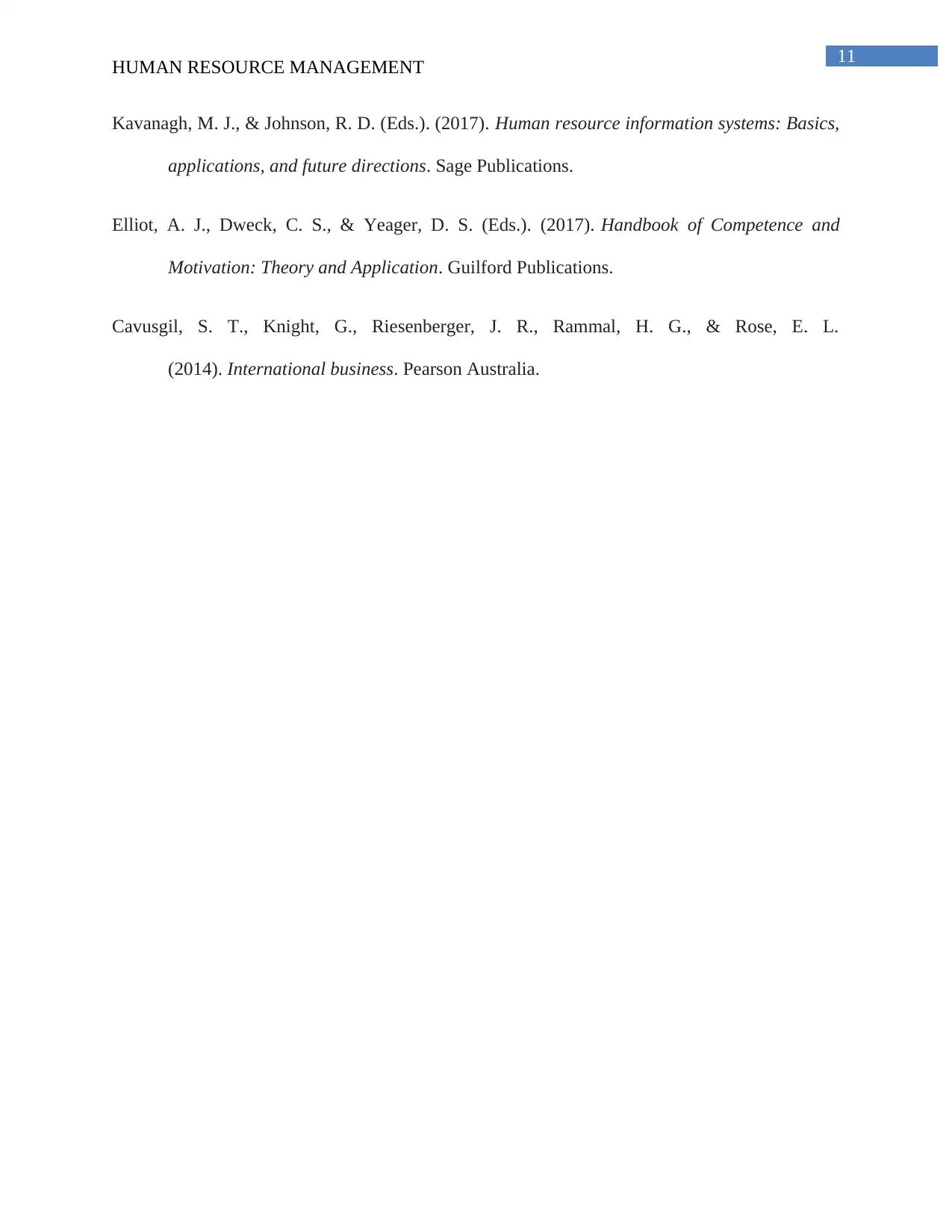
11
HUMAN RESOURCE MANAGEMENT
Kavanagh, M. J., & Johnson, R. D. (Eds.). (2017). Human resource information systems: Basics,
applications, and future directions. Sage Publications.
Elliot, A. J., Dweck, C. S., & Yeager, D. S. (Eds.). (2017). Handbook of Competence and
Motivation: Theory and Application. Guilford Publications.
Cavusgil, S. T., Knight, G., Riesenberger, J. R., Rammal, H. G., & Rose, E. L.
(2014). International business. Pearson Australia.
HUMAN RESOURCE MANAGEMENT
Kavanagh, M. J., & Johnson, R. D. (Eds.). (2017). Human resource information systems: Basics,
applications, and future directions. Sage Publications.
Elliot, A. J., Dweck, C. S., & Yeager, D. S. (Eds.). (2017). Handbook of Competence and
Motivation: Theory and Application. Guilford Publications.
Cavusgil, S. T., Knight, G., Riesenberger, J. R., Rammal, H. G., & Rose, E. L.
(2014). International business. Pearson Australia.
⊘ This is a preview!⊘
Do you want full access?
Subscribe today to unlock all pages.

Trusted by 1+ million students worldwide
1 out of 12
Related Documents
Your All-in-One AI-Powered Toolkit for Academic Success.
+13062052269
info@desklib.com
Available 24*7 on WhatsApp / Email
![[object Object]](/_next/static/media/star-bottom.7253800d.svg)
Unlock your academic potential
Copyright © 2020–2025 A2Z Services. All Rights Reserved. Developed and managed by ZUCOL.



